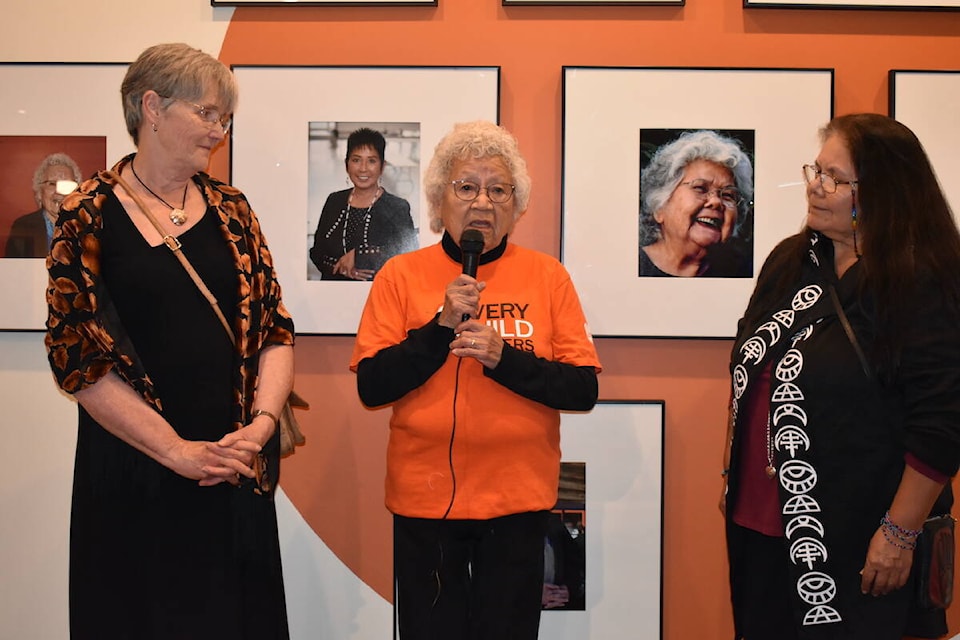By Barb Brouwer
Contributor
The life and work of a much-loved Switzmalph Elder is being celebrated in a new Salmon Arm Museum exhibition.
Knúcwentwecw: The Bridges Built by Dr. Mary Thomas opened fittingly on National Indigenous People’s Day, with a large crowd in attendance.
Knúcwentwecw is a Secwepemctsin word for helping one another, a concept the late Elder lived by.
Dr. Mary, as she was affectionately known, worked tirelessly to promote understanding and build bridges between cultures. That work and the power she had to move people are on display in recorded messages of memories and stories, photographs and Indigenous crafts made by Mary and her mother. Another intriguing component is a chronological account paralleling Mary’s life with what was happening on the global scene, such as Mary’s survival of the 2018 Spanish flu, which was rampant in the Shuswap.
The crowd stood silent in respect as Elder Ethel Thomas offered a prayer, first in Secwepemctsin, then English.
Overwhelmed by the number of guests, both Indigenous and non-Indigenous, curator/archivist Deborah Chapman told of meeting Mary in 1991 and the many discussions they shared about the Elder’s desire to create understanding between cultures.
“The idea for this exhibit was formed in 2015,” Chapman said, describing the hurdles that had to be overcome. “It wasn’t until we received funding from the City of Salmon Arm’s grant-in-aid program and the Okanagan Historical Society Salmon Arm Branch that the idea for the exhibit became more than a dream.”
The youngest of Mary’s 16 children, Bonnie, co-curated the exhibition, mentoring and guiding her and colleague Erin Stodola, said Chapman.
“Bonnie was a gift from her mother.”
Bonnie said the number of memories and stories people from all walks of life contributed to the exhibition, and continue to do so, meant Mary’s work was highly valued.
“People understood and continue to understand and that’s part of the healing, especially when it includes non-Indigenous people,” Bonnie said following the event and pointing out people attended the opening without labels such as chief or MP, just human beings together in one place – something her mother would have loved. “We are all here for a purpose and we all have a gift to bring to community.”
Referring to the crowd as extended family, Bonnie noted it is part of the Indigenous tradition and humans are but one small part of the ecosystem.
“We were all there for the purpose of honouring one person, but also the people who participated, who shared their stories,” she said pointing out her mother’s fervent wish that they, along with the culture, be passed onto future generations. “It was so inspiring. People who didn’t even know her wanted to connect to create new opportunities, to continue to share the knowledge.”
Planting of a Rocky Mountain maple, a culturally important native tree had been planned, but was postponed by heavy rain.

Phil McIntyre Paul read a story provided by Barb Craven, a member of the Switzmalph Cultural Society and BC Small Wetlands Association, who was unable to attend the opening.
The maple had many uses and was acquired as part of a “Two Billion Trees by 2030” initiative, in which the two sister organizations have planted more than 750 culturally important native trees at schools and parks and offered some for adoption.
In his own words, McIntyre-Paul said the exhibition will be at Haney for two years, but the tree will be there forever,
“It’s going to root and grow, a living reminder of the work that Mary and the Secwépemc have called us to do – to work together to take care of the land, which is all part of reconciliation.”
The exhibition is in the museum located at R.J. Haney Heritage Village and individuals who self-identify as Indigenous, Inuit or Métis will be admitted free of charge.
READ MORE: Residential school survivors reflect on National Indigenous Peoples Day
